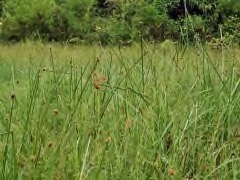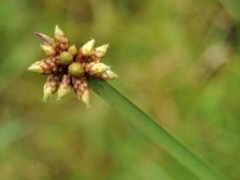 |
|
Wibowo Djatmiko (Wie146) wikimedia.org |
 |
| Wibowo Djatmiko (Wie146) wikimedia.org |
Translate this page:
Summary
Physical Characteristics

 Schoenoplectiella mucronata is an evergreen Perennial growing to 1.5 m (5ft) by 0.3 m (1ft in) at a fast rate.
Schoenoplectiella mucronata is an evergreen Perennial growing to 1.5 m (5ft) by 0.3 m (1ft in) at a fast rate.
See above for USDA hardiness. It is hardy to UK zone 10.
Suitable for: light (sandy), medium (loamy) and heavy (clay) soils. Suitable pH: mildly acid, neutral and basic (mildly alkaline) soils. It cannot grow in the shade. It prefers moist or wet soil and can grow in water.
UK Hardiness Map
US Hardiness Map
Synonyms
Eleocharis triangulata (Roxb.) Sieber ex C.Presl. Heleophylax mucronatus (L.) Schinz & Thell. Hymenochaeta preslii (A.Dietr.) Nakai. Isolepis mucronata (L.) Fourr. Schoenoplectiella triangulata (Roxb.) J.Jung & H.K.Choi. Schoenoplectus javanus (Nees) Palla. Schoenoplectus mucronatus (L.) Palla. Schoenoplectus triangulatus (Roxb.) Soják. Scirpus abactus Ohwi. Scirpus acutus J.Presl & C.Presl [Illegitimate]. Scirpus cognatus Hance. Scirpus glomeratus Scop. [Illegitimate]. Scirpus javanus Nees. Scirpus mauritanicus Steud. Scirpus mucronatus L. Scirpus muticus D.Don. Scirpus mysurensis B.Heyne ex Wall. [Invalid]. Scirpus preslii A.Dietr. Scirpus sundanus Miq. Scirpus triangulatus Roxb. Scirpus tricarinatus Pers.
Plant Habitats
Edible Uses
Edible Parts: Root
Edible Uses:
Edible Portion: Rhizome, Root.
References More on Edible Uses
Medicinal Uses
Plants For A Future can not take any responsibility for any adverse effects from the use of plants. Always seek advice from a professional before using a plant medicinally.
In China it is used medicinally to release heat, to clear the eyes and to relieve coughing.
References More on Medicinal Uses
The Bookshop: Edible Plant Books
Our Latest books on Perennial Plants For Food Forests and Permaculture Gardens in paperback or digital formats.

Edible Tropical Plants
Food Forest Plants for Hotter Conditions: 250+ Plants For Tropical Food Forests & Permaculture Gardens.
More

Edible Temperate Plants
Plants for Your Food Forest: 500 Plants for Temperate Food Forests & Permaculture Gardens.
More

More Books
PFAF have eight books available in paperback and digital formats. Browse the shop for more information.
Shop Now
Other Uses
Used in constructed wetlands. Dried stems are woven together to make various products or used as string. The stems are used in Madagascar for making hats. In South-East Asia the stems are used in the production of string, mats, sacks and bags. Ornamental Foliage. Tolerant of waterlogged soils. Landscape Uses : Pond, Lake, River, Marsh, Bog, Water Garden, Marsh Garden. Birds feed on its seeds. Carbon Farming Solutions - Industrial Crop: biomass (Crops grown for non-food uses. Industrial crops provide resources in three main categories: materials, chemicals, and energy. Traditional materials include lumber and thatch, paper and cardboard, and textiles) [1-1].
Special Uses
Carbon Farming
References More on Other Uses
Cultivation details
Industrial Crop: Biomass Management: Hay Regional Crop
Climate: warm temperate to subtropical, Mediterranean. Humidity: aquatic. A sedge with a grass-like form Growing in moist and wet terrestrial habitat, and in shallow water. The root system is well-developed. Prefers waterlogged soils in full sun. Carbon Farming Solutions - Cultivation: regional crop. Management: hay (Describes the non-destructive management systems that are used in cultivation) [1-1].
Carbon Farming
-
Industrial Crop: Biomass
Three broad categories: bamboos, resprouting woody plants, and giant grasses. uses include: protein, materials (paper, building materials, fibers, biochar etc.), chemicals (biobased chemicals), energy - biofuels
-
Management: Hay
Cut to the ground and harvested annually. Non-destructive management systems maintaining the soil organic carbon.
-
Regional Crop
These crops have been domesticated and cultivated regionally but have not been adopted elsewhere and are typically not traded globally, Examples in this broad category include perennial cottons and many nuts and staple fruits.
References Carbon Farming Information and Carbon Sequestration Information
Temperature Converter
Type a value in the Celsius field to convert the value to Fahrenheit:
Fahrenheit:
The PFAF Bookshop
Plants For A Future have a number of books available in paperback and digital form. Book titles include Edible Plants, Edible Perennials, Edible Trees,Edible Shrubs, Woodland Gardening, and Temperate Food Forest Plants. Our new book is Food Forest Plants For Hotter Conditions (Tropical and Sub-Tropical).
Shop Now
Plant Propagation
Seed, Division
Other Names
If available other names are mentioned here
Bog bulrush, rough-seed bulrush, ricefield bulrush, Scirpe mucroné (Fr). Castanhol (Po).
Native Range
TEMPERATE ASIA: Yemen, Afghanistan, Iran, Iraq, Israel, Lebanon, Turkey, Armenia, Azerbaijan, Georgia, Kazakhstan, Kyrgyzstan, Tajikistan, Uzbekistan, Mongolia, Russian Federation (Primorye), China, Korea, Japan (Honshu, Kyushu, Shikoku), Taiwan TROPICAL ASIA: Bhutan, India, Sri Lanka, Nepal, Pakistan (north), Papua New Guinea, Thailand, Vietnam, Indonesia, Malaysia, Philippines AUSTRALASIA: Australia (New South Wales, Queensland, Western Australia, Northern Territory) EUROPE: Austria, Switzerland, Germany, Hungary, Poland, Slovakia, Russian Federation (Astrakhan), Ukraine, Albania, Bulgaria, Greece, Croatia, Italy (incl. Sicily), Romania, Serbia, Slovenia, Spain, France (incl. Corsica), Portugal AFRICA: Egypt, Tanzania, Uganda, Central African Republic, Cameroon, Gabon, Guinea, Guinea-Bissau, Nigeria, Zambia, Madagascar, Mauritius, Reunion
Weed Potential
Right plant wrong place. We are currently updating this section.
Please note that a plant may be invasive in one area but may not in your area so it's worth checking.
It is a weed of rice fields in California. It is an important weed in the cultivation of rice and other crops throughout its distribution range.
Conservation Status
IUCN Red List of Threatened Plants Status : This taxon has not yet been assessed

Growth: S = slow M = medium F = fast. Soil: L = light (sandy) M = medium H = heavy (clay). pH: A = acid N = neutral B = basic (alkaline). Shade: F = full shade S = semi-shade N = no shade. Moisture: D = dry M = Moist We = wet Wa = water.
Now available:
Food Forest Plants for Mediterranean Conditions
350+ Perennial Plants For Mediterranean and Drier Food Forests and Permaculture Gardens.
[Paperback and eBook]
This is the third in Plants For A Future's series of plant guides for food forests tailored to
specific climate zones. Following volumes on temperate and tropical ecosystems, this book focuses
on species suited to Mediterranean conditions—regions with hot, dry summers and cool, wet winters,
often facing the added challenge of climate change.
Read More
Expert comment
Author
(L.) J. Jung & H. K. Choi
Botanical References
Links / References
For a list of references used on this page please go here
Readers comment
| Add a comment |
|
If you have important information about this plant that may help other users please add a comment or link below. Only comments or links that are felt to be directly relevant to a plant will be included. If you think a comment/link or information contained on this page is inaccurate or misleading we would welcome your feedback at [email protected]. If you have questions about a plant please use the Forum on this website as we do not have the resources to answer questions ourselves.
* Please note: the comments by website users are not necessarily those held by PFAF and may give misleading or inaccurate information.
To leave a comment please Register or login here All comments need to be approved so will not appear immediately.
|
Subject : Schoenoplectiella mucronata
|
|
|
|